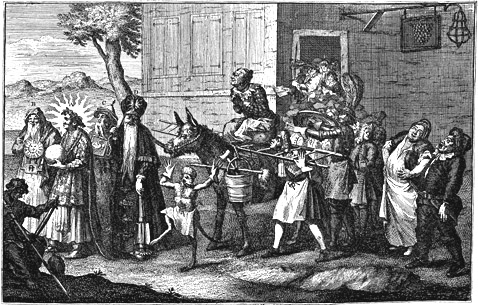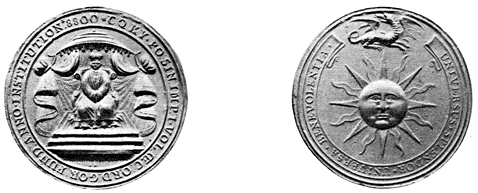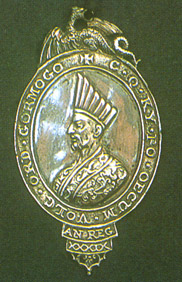|
|
|

|
The Gormogons
 |
 |  |
The Antient Noble Order of the Gormogons was a short-lived eighteenth century society; leaving no records or accomplishments to indicate its true goal and purpose. From the few published advertisements and notices, it would appear that its sole objective was to hold up Freemasonry to ridicule.
|
 |
 |
 |
The Gormogons are first heard of in a notice published in the London Daily Post for September 3, 1724:
" Whereas the truly ANTIENT NOBLE ORDER of the Gormogons, instituted by Chin-Qua Ky-Po, the first Emperor of China (according to their account), many thousand years before Adam, and of which the great philosopher Confucious was Oecumenicae Volgee, has lately been brought into England by a Mandarin, and he having admitted several Gentlemen of Honour into the mystery of that most illustrious order, they have determined to hold a Chapter at the Castle Tavern in Fleet Street, at the particular request of several persons of quality. This is to inform the public, that there will be no drawn sword at the Door, nor Ladder in a dark Room, nor will any Mason be reciev'd as a member till he has renounced his Novel Order and been properly degraded. N.B. — The Grand Mogul, the Czar of Muscovy, and Prince Tochmas are entr'd into this Hon. Society ; but it has been refused to the Rebel Meriweys, to his great Mortification. The Mandarin will shortly set out for Rome, having a particular Commission to make a Present of the Antient Order to his Holiness, and it is believ'd the whole Sacred College of Cardinals will commence Gormogons. Notice will be given in the Gazette the Day the Chapter will be held.2
|
Letters appeared in the Plain Dealer for Monday, September 14, 1724 (No. 51) attacking Freemasonry and referring to the Gormogons; and then in the British Journal for December 12, 1724: "We hear that a Peer of the first Rank, a noted Member of the Society of Free-Masons, hath suffered himself to be degraded as a member of that Society, and his Leather Apron and Gloves to be burnt, and thereupon enter'd himself as a Member of the Society of Gormogons, at the Castle-Tavern in Fleet Street." This is presumed to be a reference to Philip, Duke of Wharton.
Little is heard again of the Gormogons until the editions of the Daily Journal for October 26 and 28, 1728: "By command of the Vol-Gi. A General Chapter of the Most August and Ancient Order, GOR-MO-GON, will be held at the Castle Tavern in Fleet Street, on Saturday, the 31st Inst., to commence at 12 o'clock ; of which the several Graduates and Licentiates are to take Notice, and give their Attendance." The same year a letter by Wharton appeared in Mr. Mist’s Journal lampooning the British royal court in a similar Persian style as the Gormogon literature of 1724.
Nichols and Stevens, editors of Hogarth’s Works(1810) claim that the order was frequently advertised between October 1728 and 1730 but no records remain extant. The Weekly Journal or British Gazetteer for April 18, 1730 stated that John Dennis, poet, political writer and critic, had renounced the Gormogons and joined the Freemasons.
Wharton died on May 31, 1731, and the Gormogons were not heard from again. There is no evidence of any other members other than Wharton and Dennis. Dennis was a Whig so his alleged membership was probably a hoax. Unlike the Scald- Miserables4 , and contrary to Hogarth’s print, the Gorgomons never actually held public processions. The fullest account of the Gormogons is given in the letters of Verus Commodus, published in an appendix to the second edition of The Grand Mystery of the Freemasons Discover'd, (28 October, 1724).
There is some evidence that the Gormogons, in some fashion, lingered on:
When exactly the Gormogons died out is not known, but two considerations seem to render untenable Gould's theory that "the Order is said to have become extinct in 1738." In the first place the existence of a Lancashire Gormogon in the person of John Collier, better known as Tim Bobbin (1708-86) was revealed by the chance stumbling upon a poem of his, The Goose, by one of the present authors. The first appearance of the poem known to the authors is in Tim Bobbin's Collected Poems of 1757 and in any case very little of his verse is ascribed to a period before the last forty years of his life. The Goose has a dedication :-
" As I have the honor to be a member of the ancient and venerable order of the Gormogons, I am obliged by the laws of the great Chin-Quaiw-Ki-Po, emperor of China, to read, yearly, some part of the ancient records of that country.
The poem describes, in part, the spinning of a coin to settle a dispute about the payment for a goose :
" No sooner said than done-both parties willing
The Justice twirls aloft a splendid shilling ;
" While she, (ah nature, nature,) calls for tail,
And pity 'tis, poor soul, that she should fail
But chance decrees-up turns great Chin-Quaw-Ki-Po,
Whose very name my belly sore doth gripe-oh ! "
Secondly, Gould's theory is further stultified by the existence of some very rare but undoubtedly Gormogon medals which bear every evidence of having been minted as late as 1799.11 .
 There exists in the British Museum what may well be the only surviving specimen of a Gormogon medal which is exceedingly closely related to the very beautiful one of which a number of examples are known, and which has often been reproduced.5 .
There exists in the British Museum what may well be the only surviving specimen of a Gormogon medal which is exceedingly closely related to the very beautiful one of which a number of examples are known, and which has often been reproduced.5 .
Philip, Duke of Wharton
Although various theories have been offered as to who the Gormogons were: that the Oecumenicae Volgi was the Chevalier Ramsey, then at Rome in attendance upon the Young Pretender; that the movement was an undefined Jesuit scheme; or that the Gormogons were the precursors of the Ancient Grand Lodge of England6 . — nothing is known for fact, but all evidence suggests an attempt by Philip, Duke of Wharton, to establish a Jacobite or Catholic Club.
|
 Silver collar jewel, reverse shows sun radiating sixteen alternating straight and wavy lines.10 .
Silver collar jewel, reverse shows sun radiating sixteen alternating straight and wavy lines.10 .
|
Philip, Duke of Wharton (b. December, 1698) 7 . a Jacobite sympathizer zealous for the Hanover Settlement and one-time president of one of the three Hell-Fire Clubs in London, was a colourful figure of the period. 8 . As publisher of True Briton from June 3, 1723 until February 17, 1724, his writings resulted in his printer, Samuel Richardson, being tried for libel and his own self-exile to the Continent where his service for the King of Spain in the siege of Gibralter lead to a charge of High Treason. With his estates frozen, he was living in Rouen when he was outlawed on April 3, 1729 for not appearing on the charge of High Treason. He died in indigence at a Bernadine convent in Catalonia, May 31, 1731.9 .
His masonic history is equally colourful. While there is some question if he ever served as Master of his lodge — the Lodge at the King’s Arms, near St. Paul’s — he arranged to be elected the sixth Grand Master on June 24, 1722, when he also appointed Dr. Desaguliers his Deputy Grand Master and James Anderson a Grand Warden. The following year, at the Grand Festival of June 24, 1723, he attempted, unsuccessfully, to deprive the Grand Master of the privilege of appointing his Deputy by making the office subject to election in Grand Lodge. Unsuccessful in his attempt, the minutes of Grand Lodge record that "The late Grand Master went away from the Hall without Ceremony."
From that date he had nothing further to do with Grand Lodge, although he did constitute the first lodge in foreign parts on the rolls of the Grand Lodge of England, the Madrid Lodge, Madrid, Spain on February 15, 1728.
1.  "The Mystery of Masonry brought to light by ye Gormagons." William Hogarth, London: Printed for Robt. Sayer Map & Print Seller at No. 53 in Fleet Street. Reprinted in Ars Quatuor Coronatorum. vol. viii (1895), also vol. lxxvii (1964) p. 15. "The Mystery of Masonry brought to light by ye Gormagons." William Hogarth, London: Printed for Robt. Sayer Map & Print Seller at No. 53 in Fleet Street. Reprinted in Ars Quatuor Coronatorum. vol. viii (1895), also vol. lxxvii (1964) p. 15.
 Hogarth’s print has been tentatively dated to December 1724. The engraving appeared in three states: the first without an artist’s name, the second had Hogarth Inv : et Sculp., and the third, London, Printed for Robt. Sayer, Map & Print Seller at No. 53 in Fleet Street.
Hogarth’s print has been tentatively dated to December 1724. The engraving appeared in three states: the first without an artist’s name, the second had Hogarth Inv : et Sculp., and the third, London, Printed for Robt. Sayer, Map & Print Seller at No. 53 in Fleet Street.
 An early work by Hogarth, he copied several figures from the Don Quixote series by Charles Antoine Coypel (1694-1752). The figure with his head through a ladder may be intended to be James Anderson; the figure in armour, Philip, Duke of Wharton; and the figure on the ass is perhaps John Desaguliers. Cf: "William Hogarth and his Fraternity" AQC. lxxvii (1964) pp. 14-18.
An early work by Hogarth, he copied several figures from the Don Quixote series by Charles Antoine Coypel (1694-1752). The figure with his head through a ladder may be intended to be James Anderson; the figure in armour, Philip, Duke of Wharton; and the figure on the ass is perhaps John Desaguliers. Cf: "William Hogarth and his Fraternity" AQC. lxxvii (1964) pp. 14-18.
2.  All quotes reproduced from "Masonic Celebrities, No. VI — The Duke of Wharton, G.M., 1722-23; with which is combined the true history of the Gormogons." By Bro. R. F. Gould. AQC. pp. 114-55. Cf.: Robert Freke Gould, The History of Freemasonry. Philadelphia: The John C. Yorston Publishing Co., 1902. vol. iii, pp. 129-31.
All quotes reproduced from "Masonic Celebrities, No. VI — The Duke of Wharton, G.M., 1722-23; with which is combined the true history of the Gormogons." By Bro. R. F. Gould. AQC. pp. 114-55. Cf.: Robert Freke Gould, The History of Freemasonry. Philadelphia: The John C. Yorston Publishing Co., 1902. vol. iii, pp. 129-31.
3.  History, Gould. vol. iii, p. 41.
History, Gould. vol. iii, p. 41.
4.  The Scald-Miserables processions organized by Paul Whitehead and Esquire Carey (later Grand Steward in 1740) were held on March 19, April 27 and May 2, 1741.
The Scald-Miserables processions organized by Paul Whitehead and Esquire Carey (later Grand Steward in 1740) were held on March 19, April 27 and May 2, 1741.
55.  "A hitherto unknown Gormogon medal." Herbert Poole, AQC. vol. xxxxviii (1948), pp. 203-205.
"A hitherto unknown Gormogon medal." Herbert Poole, AQC. vol. xxxxviii (1948), pp. 203-205.
6.  Geschichte deio Freimaurerei, England, Irland, Schotand. Dr Kloss. 90.
Geschichte deio Freimaurerei, England, Irland, Schotand. Dr Kloss. 90.
7.  Conferred title in 1718 upon the death of his father, Thomas; Marquis of Malmesbury and Catherlogh, Earl of Rathfarnham, Viscount Winchendon, and Baron Trim, received Order of Garter and title of Duke of Northumberland from Old Pretender about 1726. Conferred title in 1718 upon the death of his father, Thomas; Marquis of Malmesbury and Catherlogh, Earl of Rathfarnham, Viscount Winchendon, and Baron Trim, received Order of Garter and title of Duke of Northumberland from Old Pretender about 1726.
8.  AQC vol. xi, (1898). p 86. Cf.: Philip, Duke of Wharton, Memoirs of the Life of, by an Impartial Hand, London, 1731; Select and Authentic Pieces, written by, Boulogne [Lond.] Printed by J. Wolfe, at the Duke of Wharton’s Head, 1731. AQC vol. xi, (1898). p 86. Cf.: Philip, Duke of Wharton, Memoirs of the Life of, by an Impartial Hand, London, 1731; Select and Authentic Pieces, written by, Boulogne [Lond.] Printed by J. Wolfe, at the Duke of Wharton’s Head, 1731.
9.  AQC vol. xii, p. 106. AQC vol. xii, p. 106.
10.  "...one of only three known jewels extant." Freemasonry Today Winter 2003 Issue 27, p. 46. "...one of only three known jewels extant." Freemasonry Today Winter 2003 Issue 27, p. 46.
11.  The Pocket History of Freemasonry, Fred L. Pick, G. Norman Knight. London : Frederick Muller Ltd., 1953. p. 87
The Pocket History of Freemasonry, Fred L. Pick, G. Norman Knight. London : Frederick Muller Ltd., 1953. p. 87
|
|